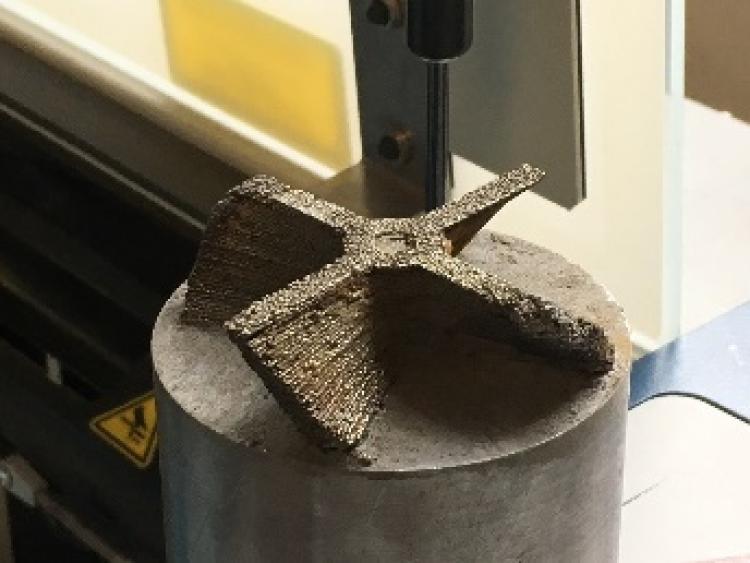Competing in a NASA student satellite design contest
Ben Fried is a second year mechanical engineering master’s student. He completed his undergraduate studies in mechanical engineering at Clarkson University, located in upstate New York. He is a 1st Lt. in the 4th Space Launch Squadron of the US Air Force, and was stationed at Vandenberg AFB, CA prior to attending CU Boulder.
The team stops for a photo with the NASA CubeQuest judges during a campus visit.
“Well, there goes our spring break!”, I thought as I read NASA’s email about the design document submission date for the Cube Quest Challenge.
Once again, NASA representatives had changed a critical milestone, one that the team would not be pleased about.
It was just another bump in the road that we would have to overcome, even if it meant working through our spring break, which is exactly what we did.
Fast forward to April 6—our 16 member team had documented over 300 pages with design schematics, simulations, models, analyses, budgets, images, and more. By the time I compressed it all into a final zip file and sent it to the NASA judges, it was about 4 am, a time when most people in Boulder were probably asleep and not dreaming about their potential ticket to space. After I clicked the “submit” button, the weight was lifted off our shoulders, and the information was in the judge’s hands.
Later in April, we again felt the burden of the competition as the judges traveled to campus to see our progress, meet the team, and get a better feel of CU-E3’s design progress. We devoted an entire day to the judges, including campus lab tours, hardware demonstrations, and tours of our partner’s facilities—Blue Canyon Technologies, and LASP. This stressful and question filled day proved to be a success, but again left us wondering how we stacked up against the competition.
In the mean time, our team continued to labor and advance the design. The semester started to wind down, anxious students began to hunt for jobs, and the search for a summer work team started.
The Trip to NASA Ames: Mountain View, CA
My alarm buzzed with an early 5 am wakeup, prompting me to prepare for the big day.
I filled my hands with our project’s poster, a Pelican case with our prototype inside, and my suitcase, and headed towards the AB bus, bound for DIA. Our 8 am flight would arrive in California around 10, and we crossed our fingers that our luggage and our tech demos would arrive with us.
The agenda for the Deep Space Symposium had the competitors presenting their designs on Wednesday, and the final winners being announced on Thursday. We were not graded on the presentations; they were simply informational to show off our custom designs and novel technologies.
For two years, we had spent countless amounts of time wondering what the other teams (Cornell, UC San Diego, MIT, Team Miles, and Team Ragnarock) had been designing; what was their game plan to win the competition? How did their designs stack up against ours? Did their teams face the same struggles that we did? Were they under the same budgetary constraints? Did they also have obligations to their other coursework? Would the judges favor them over us?
We scouted their websites, listened to the NASA telecons closely, and tried to piece together their design and mission plans. Not only were we excited to see our competitors designs’, but we also were also anxious to see what the judges had decided—who would win $20,000 and a launch slot on NASA’s EM-1 mission, and who would return home empty handed?
The event was exciting; we were the celebrities there, featuring media coverage, newspaper journalists, cameras and more. Media representatives were fighting to interview the teams and try to fathom the advanced designs. Reporters from the San Francisco Chronicles, Space News, and more were in attendance. NASA had created this symposium to show off our technology and designs, and to show the growth of the SmallSat industry, especially as it pertains to deep space. NASA executives from Washington DC were also in attendance, and were genuinely curious about our team, the design process, and our winning plans.
Thursday, Jun 8: Winner’s Announcement
Thursday morning, there was an aura in the air of the hotel lobby. Other teams had also stayed at the hotel, and our intimate breakfast conversations had revealed that we were all nervous about the results. All teams had robust designs, novel ideas, and plans to win the competition; the ball was in anyone’s court.
The teams sat in the front row of the symposium as the administrators and executives dragged out their introductions and ensured that all teams would have to continue waiting. Finally, the winners were announced:
- Cornell CisLunar Explorers
- CU Boulder CU-E3
- Team Miles
With cameras on us, we celebrated and let out a sigh of relief.
Later on after the big announcement, our payload integrator approached us for a private talk and expectations about our spacecraft. Our winning dreams had finally come true, but we also knew it was just the beginning, and the work would only be increasing.


